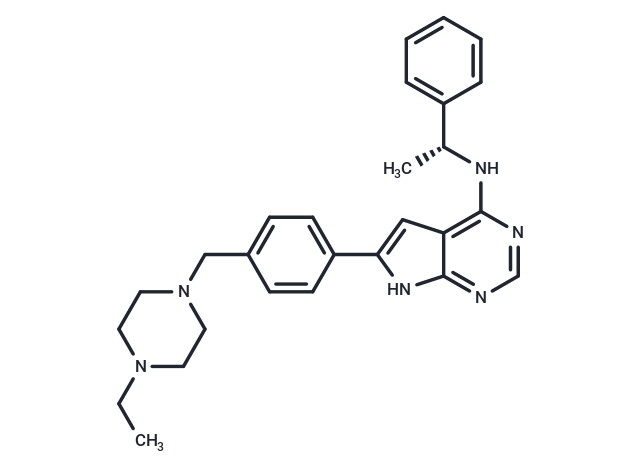Shopping Cart
- Remove All
 Your shopping cart is currently empty
Your shopping cart is currently empty

AEE788 (NVP-AEE 788) has been used in trials studying the treatment of Cancer, Glioblastoma Multiforme, and Brain and Central Nervous System Tumors.

| Pack Size | Price | Availability | Quantity |
|---|---|---|---|
| 2 mg | $39 | In Stock | |
| 5 mg | $64 | In Stock | |
| 10 mg | $105 | In Stock | |
| 25 mg | $198 | In Stock | |
| 50 mg | $343 | In Stock | |
| 100 mg | $516 | In Stock | |
| 500 mg | $1,160 | In Stock | |
| 1 mL x 10 mM (in DMSO) | $70 | In Stock |
| Description | AEE788 (NVP-AEE 788) has been used in trials studying the treatment of Cancer, Glioblastoma Multiforme, and Brain and Central Nervous System Tumors. |
| Targets&IC50 | EGFR:2 nM, HER2/ErbB2:6 nM, FLK1:59 nM, c-Fms:60 nM, c-ABL:52 nM |
| In vitro | AEE788, administered at a dosage of 50 mg/kg, effectively inhibits the growth (>50%) of cecal and peritoneal tumors and reduces the lymph node metastasis rate of HT29 cells implanted in the cecum of nude mice to 70%, without affecting the body weight. This compound causes a 57% tumor regression in the NeuT/ErbB2 GeMag model and inhibits EGFR phosphorylation induced by EGF in A431 tumors and erbB2 phosphorylation in GeMag tumors. In NCI-H596 or DU145 xenograft models, AEE788 demonstrates dose-dependent tumor growth inhibition with minimal weight changes. It enhances apoptosis by promoting the production of reactive oxygen species regulated by LBH589 in K562 tumor cells. AEE788 selectively inhibits VEGF-induced angiogenesis without affecting bFGF-induced angiogenesis and significantly lowers the expression levels of pEGFR and pVEGFR in HT29 cecal cancer, without altering the expression of EGF, VEGF, EGFR, or VEGFR. When used in combination with CPT-11, it considerably inhibits lymphoma metastasis and suppresses the growth of Daoy, DaoyPt, and DaoyHER2 transplanted tumors by 51%, 45%, and 72%, respectively. |
| In vivo | AEE788 inhibits the phosphorylation of EGFR and Akt in HT29 cells at concentrations of 0.2-1.0 μM. It also suppresses phosphorylation of EGFR, VEGFR2, Akt, and MAPK in human skin SCC cell lines (Colo16, HaCaT, SRB1, and SRB12), resulting in growth inhibition and apoptosis induction. AEE788 effectively inhibits EGFR phosphorylation in A431 cells, with an IC50 of 11 nM. Additionally, it impedes the phosphorylation of KDR in CHO cells and erbB2 in BT-474 cells, while having no effect on PDGF-induced phosphorylation in A31 cells. AEE788 targets medulloblastoma cell lines, inhibiting cell proliferation and the activation of HER1, HER2, and HER3 induced by EGF and neuregulin. It reduces cell proliferation in NCI-H596, MK, BT-474, and SK-BR-3 cells, with IC50 values of 78, 56, 49, and 381 nM, respectively. AEE788 also hinders EGF and VEGF-promoted proliferation of human umbilical vein endothelial cells, with IC50 values of 43 and 155 nM, respectively. |
| Kinase Assay | Protein Kinase Assays: The in vitro kinase assays are performed in 96-well plates (30 μL) at ambient temperature for 15–45 min using the recombinant glutathione S-transferase-fused kinase domains (4-100 ng, depending on specific activity). [γ33P]ATP is used as phosphate donor and polyGluTyr-(4:1) peptide as acceptor. With the exception of protein kinase C-α, cyclin-dependent kinase 1/cycB and protein kinase A are protamine sulfate (200 μg/mL), histone H1 (100 μg/mL), and the heptapeptide Leu-Arg-Arg-Ala-Ser-Leu-Gly (known as Kemptide Bachem) respectively and are used as peptide substrates. Assays are optimized for each kinase using the following ATP concentrations: 1.0 μM (c-Kit, c-Met, c-Fms, c-Raf-1, and RET), 2.0 μM (EGFR, erbB2, ErbB3, and ErbB4), 5.0 μM (c-abl), 8.0 μM (Flt-1, Flt-3, Flt-4, Flk, KDR, FGFR-1, and Tek), 10.0 μM (PDGFR-β, protein kinase C-α, and cyclin-dependent kinase 1), and 20.0 μM (c-Src and protein kinase A). The reaction is terminated by the addition of 20 μL 125 mM EDTA. Thirty μL (c-abl, c-Src, insulin-like growth factor-1R, RET-Men2A, and RET-Men2B) or 40 μL (all other kinases) of the reaction mixture is transferred onto Immobilon-polyvinylidene difluoride membrane, presoaked with 0.5% H3PO4 and mounted on a vacuum manifold. Vacuum is then applied and each well rinsed with 200 μL 0.5% H3PO4. Membranes are removed and washed four times with 1.0% H3PO4 and once with ethanol. Dried membranes are counted after mounting in a Packard TopCount 96-well frame and with the addition of 10 μL/well of Microscint. IC50 values (±SE) are calculated by linear regression analysis of the percentage inhibition and are averages of at least three determinations. |
| Cell Research | Methylene Blue Cell Proliferation Assay.Cells are seeded at 1.5 × 103 cells/well into 96-well microtiter plates and incubated overnight at 37 °C, 5% v/v CO2 and 80% relative humidity. AEE788 dilutions are added on day 1, with the highest concentration being 10 μM. After incubation of the cell plates for an additional 4 (T24) or 6 (BT-474, SK-BR-3, and NCI-H596) days, cells are fixed with 3.3% v/v glutaraldehyde, washed with water, and stained with 0.05% w/v methylene blue. After washing, the dye is eluted with 3% HCl and the absorbance measured at 665 nm with a SpectraMax 340 spectrophotometer. IC50 values are determined by mathematical curve-fitting and are defined as the drug concentration leading to 50% inhibition of net cell mass increase compared with untreated control cultures. (Only for Reference) |
| Alias | NVP-AEE 788 |
| Molecular Weight | 440.58 |
| Formula | C27H32N6 |
| Cas No. | 497839-62-0 |
| Smiles | CCN1CCN(Cc2ccc(cc2)-c2cc3c(N[C@H](C)c4ccccc4)ncnc3[nH]2)CC1 |
| Relative Density. | no data available |
| Storage | Powder: -20°C for 3 years | In solvent: -80°C for 1 year | Shipping with blue ice. | |||||||||||||||||||||||||||||||||||
| Solubility Information | Ethanol: < 1 mg/mL (insoluble or slightly soluble) DMSO: 82 mg/mL (186.12 mM), Sonication is recommended. | |||||||||||||||||||||||||||||||||||
Solution Preparation Table | ||||||||||||||||||||||||||||||||||||
DMSO
| ||||||||||||||||||||||||||||||||||||

Copyright © 2015-2025 TargetMol Chemicals Inc. All Rights Reserved.